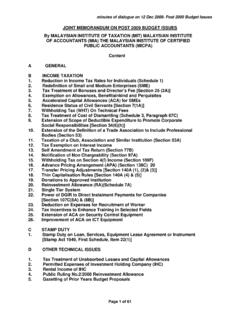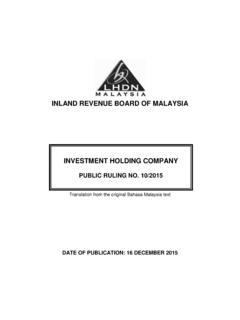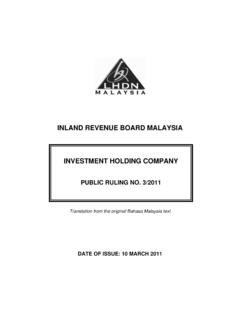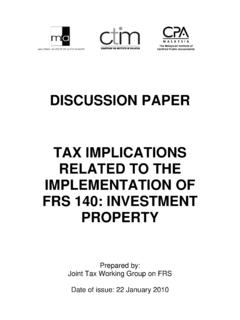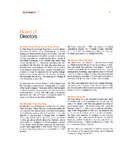Transcription of SUMMARY OF TAX CASES - MICPA
1 219 SSUUMMMMAARRYY OOFF TTAAXX CCAASSEESSCPA Tax & Investment Review V KETUA PENGARAH HASIL DALAM NEGERI (2000)MSTC 3,381 FactsThe taxpayer was a Malaysian citizen employed by a MalaysianCompany ( ). In the year of assessment 1997 (YA97), thetaxpayer was resident within the meaning of Section 7 of theIncome Tax Act, 1967 (ITA), despite the fact that the taxpayer waspresent in the United States of America (USA) for 302 days dur-ing YA97, ( during 1996). As part of his employment the taxpayer was required to be in the USA for the periodof time mentioned above. During this time, his wages andbonuses were paid into his personal account at his bank accountin Malaysia.
2 As his duties in the USA were incidental to the exer-cise of his employment with , the income arising therefromwas deemed derived from Malaysia pursuant to sections 13(2)(a)and 13(2)(c) of the ITA. The taxpayer paid Malaysian tax on thisincome, as well as federal and state taxes in the USA. The taxpayer sought unilateral relief in respect of the federal taxsuffered in the USA amounting to RM1, The claim wasmade pursuant to paragraph 15 of Schedule 7, ITA. The InlandRevenue Board (IRB) did not allow the claim on the basis thatthe income was not foreign income, as it was deemed derivedfrom Malaysia pursuant to section 13(2), unilateral relief available to the taxpayer pursuant to para-graph 15, Schedule 7, ITA?
3 ArgumentsTaxpayerThe taxpayer argued that the phrase income from an employ- ment exercised outside Malaysia in paragraph 15, Schedule 7,referred to income in respect of an employment pursuant towhich the employee is required to perform duties outsideMMaallaayyssiiaann SSppeecciiaallCCoommmmiissssiioonneerrss '' DDeecciissiioonnssA2214 SUMMARY of Tax CasesMalaysia regardless of whether -the duties are incidental to the exercise of such employ- ment ;- such employment is in Malaysia; and-such income is derived (or deemed to be derived) fromMalaysia or from outside IRB argued that notwithstanding the double tax suffered bythe taxpayer, unilateral relief was not available because thephrase income from an employment exercised outsideMalaysia referred only to foreign income within the meaning ofparagraph 16, Schedule 7, ITA.
4 Foreign income is defined inparagraph 16 to mean income derived from outside Malaysia . DecisionHeld: The taxpayer s appeal was allowed for the following rea-sons:(1) While it is important to read paragraphs 13 to 15 ofSchedule 7, as well as Section 13(2), etc., the clear lan-guage used in paragraph 15, means that this paragraphcan stand alone. It is clearly specific only to employmentincome in respect of an employment exercised outsideMalaysia involving Malaysian as well as foreign tax. (2) In statutory interpretation, effect should be given to theordinary meaning of a word.(3) Paragraph 15 uses the word may , and in this connection,it should be construed as shall and does not give theIRB the discretion to decide whether or not to grant uni-lateral relief.
5 (Note: The IRB had subsequently withdrawn its appeal to theHigh Court.) SDN BHD V KETUA PENGARAH HASIL DALAM NEGERI(2002) MSTC 3,390 FactsThe taxpayer was an investment holding company . It enteredinto a sale and purchase agreement with a third party (PNS) toacquire shares and warrants from PNS for a total considerationCPA Tax & Investment Review 2003222of RM496,270,479. To facilitate the acquisition of the shares andwarrants, the taxpayer entered into a guarantee facility agree- ment with a bank. The guarantee facility agreement was grantedto enable the taxpayer to furnish PNS an irrevocable bank guar-antee for the purchase price of the shares and warrants.
6 In con-sideration for the bank guarantee facility, the taxpayer wasrequired to pay a guarantee commission and additional fee forextending the use of the guarantee. It sought to deduct thesecosts ( the bank guarantee commission and additional fees)as being expenses wholly and exclusively incurred in the pro-duction of its business investment income. The IRB disalloweda deduction for the bank guarantee commission and guaranteefacility extension the bank guarantee commission and extension feesdeductible under Section 33(1) of the ITA?ArgumentsTaxpayer(1) The taxpayer was carrying on the business of an invest - ment holding company , and quarterly payments for theuse of the guarantee facility were revenue expenses whol-ly and exclusively incurred in the production of the tax-payer s income.
7 (2) The consideration for the purchase of the shares and war-rants should be differentiated from the consideration forthe use of the guarantee facilities.(3) The payments were akin to the payment of interest on aloan as the bank guarantee was in lieu of a loan, andhence the payments should be deductible under Section33(1)(a).(4) Alternatively, where reasonable doubt exists as towhether the payments were revenue or capital in nature,then the practical business approach should be adoptedto regard the expenses as being wholly and exclusivelyincurred in the production of (1) The payments for the use and extension of the guaranteefacility were not wholly and exclusively incurred in theproduction of income and therefore were not deductibleunder Section 33(1), ITA, as the taxpayer was an invest - ment holding company (2) Further, Section 39(1)(c) specifically prohibited a deduc-tion for the payments on the basis that these were capitalin nature.
8 (3) The payments were incurred for the purpose of acquiringassets of a capital nature, and not for the production ofincome itself.(4) The payments were not in the nature of interest, as thetaxpayer had not taken out a loan, and further had notpaid PNS the purchase : The taxpayer s appeal was disallowed for the following rea-sons:(1) While the use of the bank guarantee facility satisfiedsome of the limbs of the deductibility test laid out bySection 33(1), the fees were not incurred in the produc-tion of gross income of the taxpayer, and hence notdeductible under Section 33(1).(2) Further, the purpose of the bank guarantee facility was toenable the taxpayer to acquire the shares and warrants,which constituted capital assets of the taxpayer.
9 The pay-ments for the use of this facility were therefore related tothe cost of acquiring the capital assets, and hence thepayments were capital in nature.(3)The mere fact that a payment is recurrent does not meanthat the payment is revenue in nature. Although the pay-ments recurred, this did not change the nature of the pay-ments.(4) The fees for the use of the guarantee facility were not akinto a loan, and the facility was an undertaking given to PNSby the bank to ensure that the taxpayer would make pay- ment to PNS for the full purchase price of the shares andwarrants. No payments had actually been made to PNSby the taxpayer for the purchase of the shares.
10 (5) On the facts, there is no doubt as to the nature of theguarantee facility fees, and hence the requirement toadopt the practical business approach was not necessary,as this was not a borderline case . 2234 SUMMARY of Tax CasesCPA Tax & Investment Review 2003224(Note: The High Court had subsequently overturned the deci-sion.) holdings SDN BHD V KETUA PENGARAH HASIL DALAMNEGERI (2002) MSTC 3,403 FactsThe taxpayer was incorporated as a joint venture company in1984. Its principal activity was that of property development. InMay 1989, real property ( the subject property ) was injected intothe company at a cost of RM25 million. The subject propertyappeared as fixed assets in the annual accounts for the yearsended 31 January, 1990 and 1991 respectively.




